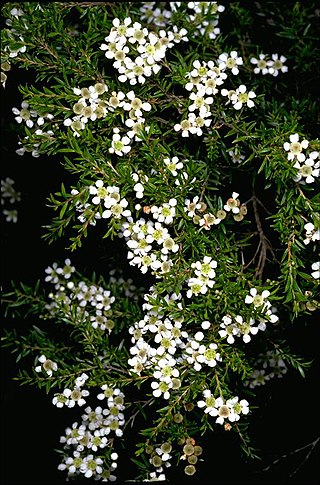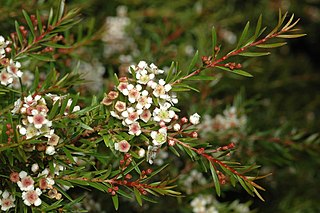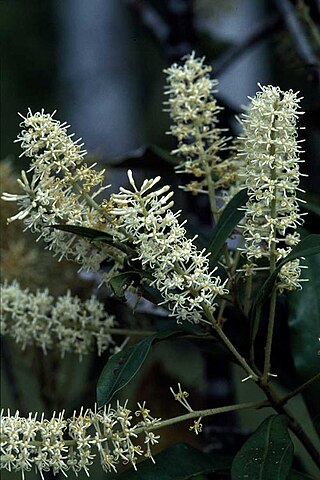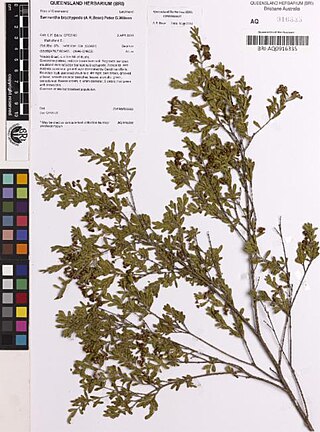
Argophyllum is a genus in the Argophyllaceae family comprising eighteen species of shrubs and small trees. They feature alternate, simple leaves, often silvery white underneath. They appear in Australia and New Caledonia, where several species are nickel hyperaccumulators.

Sannantha similis is a species in the myrtle family, Myrtaceae and is endemic to eastern Australia. It is a shrub with narrowly lance-shaped leaves, and groups of three white flowers arranged in leaf axils.

Sannantha bidwillii is a species in the myrtle family, Myrtaceae and is endemic to coastal Queensland in Australia. It is a shrub or tree with elliptic to egg-shaped leaves with the narrower end towards the base, and clusters of 3 white flowers.

Nothorites is a monotypic genus in the macadamia family Proteaceae. The sole species, Nothorites megacarpus, is endemic to the wet tropics rain forests of northeastern Queensland, Australia.
Zieria alata is a plant in the citrus family Rutaceae and is only found on mountains in the Mossman and Daintree areas in Queensland. It is an open shrub with wiry, lumpy branches, three-part leaves and small, white, cream-coloured or pale pink flowers in small groups, each with four petals and four stamens.
Zieria bifida is a plant in the citrus family Rutaceae and is only known from two areas near Nambour in Queensland. It is an open, straggly shrub with hairy branches, three-part leaves and small, white flowers in small groups, each flower with four petals and four stamens.
Zieria insularis is a plant in the citrus family Rutaceae and endemic to tropical north-eastern Queensland. It is an open, straggly shrub with wiry or spindly branches, three-part leaves and between one and a few white flowers with four petals and four stamens arranged in the leaf axils. It mostly grows near granite outcrops which are surrounded by forest or rainforest.
Leptospermum pallidum is a species of spreading shrub that is endemic to Queensland. It has thin, firm, rough bark, narrow lance-shaped leaves, white flowers arranged in groups of two or three on side shoots and fruit that remains on the plant until it dies.

Argophyllum curtum is a plant in the Argophyllaceae family endemic to a small part of north eastern Queensland. It was described and named in 2018.

Argophyllum palumense is a plant in the Argophyllaceae family endemic to a small part of north eastern Queensland. It was described and named in 2018.
Argophyllum loxotrichum is a plant in the Argophyllaceae family endemic to a small part of north eastern Queensland. It was described and named in 2018.

Dendrocnide cordifolia, commonly known as the stinging tree, is a plant in the nettle family Urticaceae endemic to the Atherton Tablelands, south west of Cairns, Queensland. Contact with the plant results in a painful sting, however the intensity and duration of the pain from this plant is extreme.
Argophyllum lejourdanii is a plant in the Argophyllaceae family endemic to a part of north eastern Queensland, Australia. It was described and named in 1863.
Argophyllum ferrugineum is a plant in the Argophyllaceae family endemic to a small part of north eastern Queensland. It was described and named in 2018.
Argophyllum iridescens is a plant in the Argophyllaceae family endemic to a small part of north eastern Queensland. It was described and named in 2018.

Sannantha brachypoda is a species in the myrtle family, Myrtaceae and is endemic to central Queensland in Australia. It is a shrub with egg-shaped leaves, the narrower end towards the base, and groups of 3 white flowers arranged in leaf axils.

Polyosma rhytophloia, commonly known as wrinkled bark polyosma, is a plant in the family Escalloniaceae which is endemic to parts of eastern Queensland, Australia. It was first described in 1926.

Rubus queenslandicus, commonly known as bramble-of-the-cape, rose-leaf bramble, or native raspberry, is a plant in the rose family Rosaceae which is endemic to a small part of northeastern Queensland, Australia, where it is found on the margins of highland forest. Prior to 1997, collections of this plant were identified as either R. rosifolius, R. fraxinifolius or R. muelleri/R. probus.

Micromyrtus delicata is a species of flowering plant in the myrtle family, Myrtaceae and is endemic to a small area of northern coastal Queensland. It is a shrub with overlapping, linear to narrowly egg-shaped leaves with the narrower end towards the base and small white flowers arranged singly in leaf axils.

Argophyllum cryptophlebum is a plant in the Argophyllaceae family of the order Asterales, which is endemic to a small part of north eastern Queensland. It was described and named in 1907.












